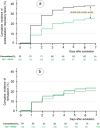Weaning of non COPD patients at high-risk of extubation failure assessed by lung ultrasound: the WIN IN WEAN multicentre randomised controlled trial
- PMID: 39593129
- PMCID: PMC11590311
- DOI: 10.1186/s13054-024-05166-w
Weaning of non COPD patients at high-risk of extubation failure assessed by lung ultrasound: the WIN IN WEAN multicentre randomised controlled trial
Abstract
Background: Postextubation respiratory failure (PRF) frequently complicates weaning from mechanical ventilation and may increase morbidity/mortality. Noninvasive ventilation (NIV) alternating with high-flow nasal oxygen (HFNO) may prevent PRF.
Methods: Ventilated patients without chronic obstructive pulmonary disease (COPD) and at high-risk of PRF defined as a lung ultrasound score (LUS) ≥ 14 assessed during the spontaneous breathing trial, were included in a French-Chinese randomised controlled trial. PRF was defined by 2 among the following signs: SpO2 < 90%; Respiratory rate > 30 /min; hypercapnia; haemodynamic and/or neurological disturbances of respiratory origin. In the intervention group, prophylactic NIV alternating with HFNO was administered for 48 h following extubation. In the control group, conventional oxygen was used. Clinicians were informed on the LUS in the intervention group, those in the control group remained blind. The primary outcome was the incidence of PRF 48 h after extubation. Secondary outcomes were incidence of PRF and reintubation at day 7, number of ventilator-free days at day 28, length of ICU stay and mortality at day 28 and 90.
Results: Two hundred and forty patients were randomised and 227 analysed (intervention group = 128 and control group = 99). PRF at H48 was reduced in the intervention group compared to the control group: relative risk 0.52 (0.31 to 0.88), p = 0.01. The benefit persisted at day 7: relative risk 0.62 (0.44 to 0.96), p = 0.02. Weaning failure imposing reconnection to mechanical ventilation was not reduced. In patients who developed PRF and were treated by rescue NIV, reintubation was avoided in 44% of control patients and in 12% of intervention patients (p = 0.008). Other secondary outcomes were not different between groups. From a resource utilisation standpoint, prophylactic NIV alternating with HFNO was more demanding and costly than conventional oxygen with rescue NIV to achieve same clinical outcome.
Conclusions: Compared to conventional oxygenation, prophylactic NIV alternating with HFNO significantly reduced postextubation respiratory failure but failed to reduce reintubation rate and mortality in patients without COPD at high risk of extubation failure. Prophylactic NIV alternating with HFNO was as efficient as recue NIV to treat postextubation respiratory failure.
Keywords: High flow nasal oxygen; Lung ultrasound score; Noninvasive ventilation; Postextubation respiratory failure; Reintubation; Weaning.
© 2024. The Author(s).
Conflict of interest statement
Declarations. Ethics approval and consent to participate: The study was approved by the Ethics Committee Sud-Est VI of Clermont-Ferrand, France and by the local Ethics Committee of each Chinese centre. The WIN-IN-WEAN study was registered at ClinicalTrials.gov with identifier number 1 NCT02123940. Consent for publication: Not applicable. Competing interests: J-M. Constantin reports personal fees and non-financial support from Drager, GE Healthcare, Sedana Medical, Baxter, and Amomed; personal fees from Fisher and Paykel Healthcare, Orion, Philips Medical, and Fresenius Medical Care; and non-financial support from LFB and Bird Corporation, outside of the submitted work. All other authors declare that they have no competing interests.
Figures


References
-
- Tobin MJ, Jubran A. Weaning from mechanical ventilation. In: Tobin MJ, editor. Principles and practice of mechanical ventilation. 2nd ed. New York: McGraw-Hill Medical Publishing Division; 2006. p. 1185–220.
-
- Tobin MJ, Laghi F. Extubation. In: Tobin MJ, editor. Principles and practice of mechanical ventilation. 2nd ed. New York: McGraw-Hill Medical Publishing Division; 2006. p. 1221–37.
-
- Béduneau G, Pham T, Schortgen F, Piquilloud L, Zogheib E, Jonas M, et al. Epidemiology of weaning outcome according to a new definition. The WIND study. Am J Respir Crit Care Med. 2017;195(6):772–83. - PubMed
-
- Thille AW, Richard JC, Brochard L. The decision to extubate in the intensive care unit. Am J Respir Crit Care Med. 2013;187(12):1294–302. - PubMed
-
- Thille AW, Monseau G, Coudroy R, Nay MA, Gacouin A, Decavèle M, et al. HIGH-WEAN Study Group and the REVA Research Network. Non-invasive ventilation versus high-flow nasal oxygen for postextubation respiratory failure in ICU: a post-hoc analysis of a randomized clinical trial. Crit Care 2021;25(1):221. - PMC - PubMed
Publication types
MeSH terms
LinkOut - more resources
Full Text Sources
Miscellaneous

